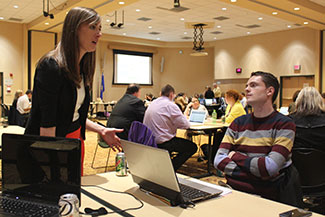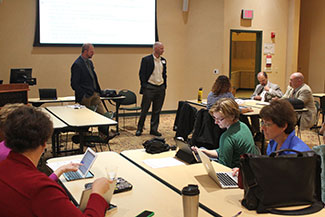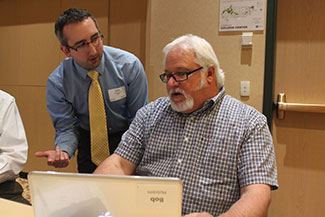Educators learn value of value added at statewide conference
JUNE 2013
 Critical changes are taking place inside the Wisconsin public educational system - among them the implementation of Common Core standards, next-generation assessments, and value-added measures. According to Value-Added Research Center researcher and associate director Bradley Carl, the changes have the power to create substantial gains in learning amongst Wisconsin’s school-aged children, but must be well-implemented, evaluated, and adjusted accordingly in order to achieve their intended outcomes.
Critical changes are taking place inside the Wisconsin public educational system - among them the implementation of Common Core standards, next-generation assessments, and value-added measures. According to Value-Added Research Center researcher and associate director Bradley Carl, the changes have the power to create substantial gains in learning amongst Wisconsin’s school-aged children, but must be well-implemented, evaluated, and adjusted accordingly in order to achieve their intended outcomes.
On May 17, Carl was one of the featured speakers at Wisconsin’s Value-Added Network Conference, which took place at Waukesha County Technical College. Carl said the conference, and events like it, serve as powerful tools to inform key stakeholders, such as teachers and school administrators, of the educational improvements value added can create in schools across the state.
“Creating the best models and systems for educator effectiveness is a constantly evolving process, which makes it tricky to explain and get people to accept and adopt,” he said. “Providing a forum to answer questions and share information – that’s what makes meetings like these so important.”
Educators from across Wisconsin attended the conference, which was co-hosted by VARC and by Cooperative Education Service Agency (CESA) #2. The conference featured informational talks, workshops, and round-table discussions and included tips on understanding value-added reports and recommendations for acting on the results; advice for talking about value added with teachers and parents; and using complementary tools including WISEdash, Student Learning Objectives, and S.M.A.R.T. Goals.
 “When I attend these conferences, there are always important pieces of information that staff in my district will need to know,” said Steve Miller, the director of standards, assessment, and accountability for Racine Unified School District. “Some staff less familiar with educator effectiveness measures find them confusing and frustrating, and honestly, it can be confusing because to some extent, the plane is being built in the air regarding educator effectiveness in Wisconsin. So it’s vitally important to try to bring the various stakeholder groups into understanding more as we learn more.”
“When I attend these conferences, there are always important pieces of information that staff in my district will need to know,” said Steve Miller, the director of standards, assessment, and accountability for Racine Unified School District. “Some staff less familiar with educator effectiveness measures find them confusing and frustrating, and honestly, it can be confusing because to some extent, the plane is being built in the air regarding educator effectiveness in Wisconsin. So it’s vitally important to try to bring the various stakeholder groups into understanding more as we learn more.”
One of the conference’s featured speakers, Todd Hellman of Battelle for Kids, said getting educators to overcome their fears of accountability measures is a delicate procedure.
"People are down on what they're not up on," Hellman said. "Leading the conversation through value-added measures of educator effectiveness is important. This will allow people to arrive at their own conclusions about questions regarding why value added is important and what they can achieve with it."
Hellman’s goal for the conference seemed to have been at least partially successful. For example, Christa Macomber, the data and assessment coordinator for Monona Grove School District, said she wished administrators and those in positions similar to hers across the state could have been more involved in the discussion of value-added implementation in Wisconsin. However, she said her takeaway from the conference was that, if value added is explained to the state’s teachers using Hellman and Carl’s gentle approach, it will be well received.
“Teachers will see that it helps to level the playing field,” she said. “If it’s explained the right way, it will alleviate concerns teachers have.”
 Bob Holzem, the director of alternative schools and programs for Racine Unified School District and principal of Walden, a Grade 6-12 magnet school in Racine, said the conference has given him useful information for how to use value added to help teachers at his school improve their teaching.
Bob Holzem, the director of alternative schools and programs for Racine Unified School District and principal of Walden, a Grade 6-12 magnet school in Racine, said the conference has given him useful information for how to use value added to help teachers at his school improve their teaching.
“We’re gaining a growing level of comfort using it as a tool,” he said. “Most educators would rather not have to go through layer after layer of testing, but with this kind of report, it helps teachers see the effects of their efforts day-to-day in the classroom, which is an incredibly valuable tool.”
The specific timeline along which teacher-level value-added measures will become part of Wisconsin’s educator effectiveness system is unclear, said VARC’s Carl. As more and more school districts in the state begin to access and review value-added measures at the district, school, and grade levels, however, VARC has recognized the need to provide more educational opportunities to educators and administrators, he said.
“We’ve got to improve the system and improve the job we’re doing for Wisconsin’s kids, and while value added by itself is not a perfect indicator of school performance, it’s much better than the attainment-based measures we’ve been using for this purpose,” Carl said. “Properly used in conjunction with other measures of performance, value-added is an extremely useful and appropriate measure of school and educator performance that has been endorsed for use statewide in the coming years.”
